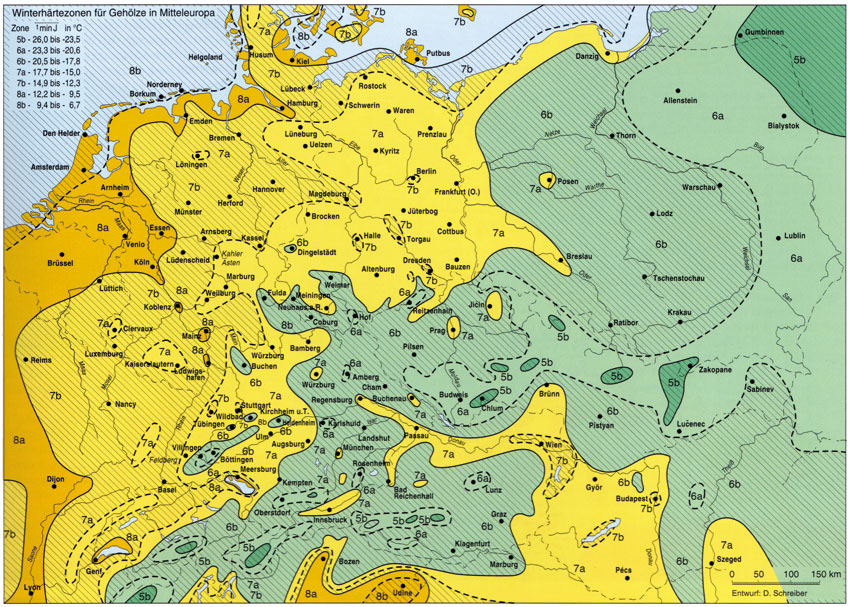The above map of winter hardiness zones for woody plants in Europe was developed by W. Heinz and D. Schreiber (Mitteilungen der Deutschen Dendrologischen Gesellschaft Nr. 75) and first published by Bärtels, A., „Gartengehölze“, published by Eugen Ulmer, Stuttgart, 1981. On our website, the winter hardiness zones are indicated at the end of each plant description after the usage symbols.

| Zone | tminJ in °C |
|---|---|
| 5b | -26.0 to -23.5 |
| 6a | -23.3 to -20.6 |
| 6b | -20.5 to -17.8 |
| 7a | -17.7 to -15.0 |
| 7b | -14.9 to -12.3 |
| 8a | -12.2 to -9.5 |
| 8b | -9.4 to -6.7 |
Foundation
The basis of the winter hardiness zones is the average annual minima of air temperature.
Temperature Ranges
For Europe, 11 zones are designated with temperature ranges of 5.5˚C each. In Central Europe, only zones 5 to 8 occur. Their subdivision into half-zones takes into account the relatively small-scale Central European climate.
Assignment
The assignment to a winter hardiness zone provides indications of its coldest cultivation area. However, this designation should not be taken too literally, as it often thrives in the respective warmer zones as well. It can be assumed that trees and shrubs in the specified, i.e., coldest zone of their cultivation area have a survival chance of about 80 percent, which significantly increases in the next warmer zone.
Local Climate
Each zone on the map indicates the average hardness (severity) of winters. However, within a zone, there are many local climatic variations. Proximity to houses, especially urban development, as well as a south-facing, sheltered slope create significantly milder conditions, while depressions, valleys, and north-facing slopes are less favorable. They can have the effect of at least one following zone.
Rivers
In low-lying areas, there are relatively mild sections when the water of larger, industry-influenced warm streams or fast-flowing rivers does not freeze. This warms the air during cold winter weather but also generates valley fog, which reduces further cooling through radiation. Such local climatic deviations usually have the effect of a half-zone level.
Extremes
In extremely cold winters, where the average annual minima of air temperature are significantly undershot, more sensitive shrubs are at risk. By choosing sites that are favorable in terms of microclimate and through winter protection, frost damage can be prevented or reduced.
Frost Hardiness
While it is an inherited trait, it is shaped by site factors within genetic variability. These include specific soil conditions and nutrient availability, as well as the weather patterns in autumn and winter.
Weather Patterns
A dry autumn promotes early shoot closure and thus maturation. In contrast, a warm and very rainy autumn, especially if it lasts a long time, can be detrimental. A gradual increase in cold promotes frost hardiness. An early first night frost halts growth, thus contributing to frost hardiness. However, lower negative temperatures during this period are very dangerous, and the effects are often only visible in late spring.
Continental Climate
In continental areas, trees receive a higher heat sum during the growing season than in maritime areas. The plants mature more reliably, which promotes their frost hardiness.
Temperature Changes
Continental climate is characterized by stronger temperature extremes; the plants native to these areas are therefore quite frost hardy. The same species lose this trait in maritime climates, where they tolerate far fewer low temperatures. They are particularly sensitive to multiple changes between frost and warm periods.
